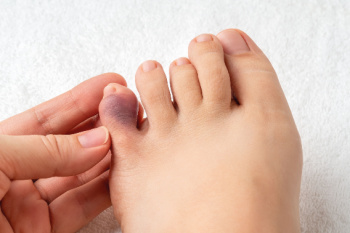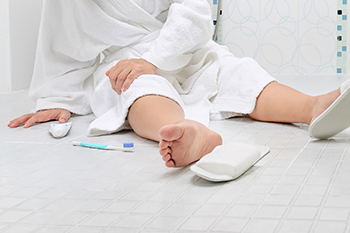Connect With Us
Blog
Items filtered by date: August 2024
Broken Pinky Toes

A broken pinky toe often results from accidental impact or trauma, such as stubbing the toe or dropping a heavy object on it. The symptoms of a fractured pinky toe include significant pain, swelling, bruising, and difficulty in moving the toe. In severe cases, the toe may appear deformed or out of alignment. To find relief, it is essential to rest the injured foot and avoid putting weight on it. Relief may be found by elevating the foot as this can assist in minimizing inflammation. Mild pain relievers may alleviate discomfort. In cases of severe injury or if the toe appears dislocated, seeking medical attention from a podiatrist is critical for a proper diagnosis and treatment. If you have fractured your toe, it is suggested that you promptly contact this foot doctor for the appropriate treatment.
A broken toe can be very painful and lead to complications if not properly fixed. If you have any concerns about your feet, contact Magdy Issa, DPM from Charlotte Family Podiatry and Wound Center. Our doctor will treat your foot and ankle needs.
What to Know About a Broken Toe
Although most people try to avoid foot trauma such as banging, stubbing, or dropping heavy objects on their feet, the unfortunate fact is that it is a common occurrence. Given the fact that toes are positioned in front of the feet, they typically sustain the brunt of such trauma. When trauma occurs to a toe, the result can be a painful break (fracture).
Symptoms of a Broken Toe
- Throbbing pain
- Swelling
- Bruising on the skin and toenail
- The inability to move the toe
- Toe appears crooked or disfigured
- Tingling or numbness in the toe
Generally, it is best to stay off of the injured toe with the affected foot elevated.
Severe toe fractures may be treated with a splint, cast, and in some cases, minor surgery. Due to its position and the pressure it endures with daily activity, future complications can occur if the big toe is not properly treated.
If you have any questions please feel free to contact our office located in Charlotte, NC . We offer the newest diagnostic and treatment technologies for all your foot and ankle needs.
Affected Age Groups and Symptoms of Sever’s Disease

Sever's disease, also known as calcaneal apophysitis, is a common condition affecting children and adolescents, particularly those aged 8 to 14. It occurs when the growth plate in the heel becomes inflamed due to repetitive stress or overuse. This inflammation results from the strong pull of the Achilles tendon on the developing heel bone. Symptoms of Sever's disease can include heel pain, tenderness, and swelling, particularly during or after physical activities like running or jumping. Children may also experience discomfort while walking or participating in sports. This condition often resolves with rest, wearing proper footwear, and stretching exercises for the calf muscles and Achilles tendon. If your active child has heel pain, it is suggested that you promptly consult a podiatrist who can provide an accurate diagnosis and offer treatment.
Sever's disease often occurs in children and teens. If your child is experiencing foot or ankle pain, see Magdy Issa, DPM from Charlotte Family Podiatry and Wound Center. Our doctor can treat your child’s foot and ankle needs.
Sever’s Disease
Sever’s disease is also known as calcaneal apophysitis, which is a medical condition that causes heel pain I none or both feet. The disease is known to affect children between the ages of 8 and 14.
Sever’s disease occurs when part of the child’s heel known as the growth plate (calcaneal epiphysis) is attached to the Achilles tendon. This area can suffer injury when the muscles and tendons of the growing foot do not keep pace with bone growth. Therefore, the constant pain which one experiences at the back of the heel will make the child unable to put any weight on the heel. The child is then forced to walk on their toes.
Symptoms
Acute pain – Pain associated with Sever’s disease is usually felt in the heel when the child engages in physical activity such as walking, jumping and or running.
Highly active – Children who are very active are among the most susceptible in experiencing Sever’s disease, because of the stress and tension placed on their feet.
If you have any questions, please feel free to contact our office located in Charlotte, NC . We offer the newest diagnostic and treatment technologies for all your foot and ankle injuries.
Ankle Fracture? Don’t Wait for Treatment
Avoiding Falls at Home

More than a quarter of people aged 65 and older fall each year. Among the factors that can lead to a fall at home are muscle weakness, loose throw rugs, and numbness in the feet. Unsafe footwear, such as backless shoes and high heels, is another factor. With a few preventative measures implemented, you can reduce the chances of falling and maintain an active life as a senior. Staying physically active is especially important as one age. Regular exercise improves muscle strength and can help keep your joints, tendons, and ligaments flexible. Standing up slowly after lying down or sitting for a prolonged period of time can help, along with using a cane or walker as needed to aid in balance. Wear shoes or slippers with non-skid soles that fully support the feet. If you feel that you have an increased risk for falls, or are planning a new exercise regime, it is suggested that you contact a podiatrist for information on fall prevention and suggested treatment options.
Preventing falls among the elderly is very important. If you are older and have fallen or fear that you are prone to falling, consult with Magdy Issa, DPM from Charlotte Family Podiatry and Wound Center. Our doctor will assess your condition and provide you with quality advice and care.
Every 11 seconds, an elderly American is being treated in an emergency room for a fall related injury. Falls are the leading cause of head and hip injuries for those 65 and older. Due to decreases in strength, balance, senses, and lack of awareness, elderly persons are very susceptible to falling. Thankfully, there are a number of things older persons can do to prevent falls.
How to Prevent Falls
Some effective methods that older persons can do to prevent falls include:
- Enrolling in strength and balance exercise program to increase balance and strength
- Periodically having your sight and hearing checked
- Discuss any medications you have with a doctor to see if it increases the risk of falling
- Clearing the house of falling hazards and installing devices like grab bars and railings
- Utilizing a walker or cane
- Wearing shoes that provide good support and cushioning
- Talking to family members about falling and increasing awareness
Falling can be a traumatic and embarrassing experience for elderly persons; this can make them less willing to leave the house, and less willing to talk to someone about their fears of falling. Doing such things, however, will increase the likelihood of tripping or losing one’s balance. Knowing the causes of falling and how to prevent them is the best way to mitigate the risk of serious injury.
If you have any questions, please feel free to contact our office located in Charlotte, NC . We offer the newest diagnostic and treatment technologies for all your foot care needs.

